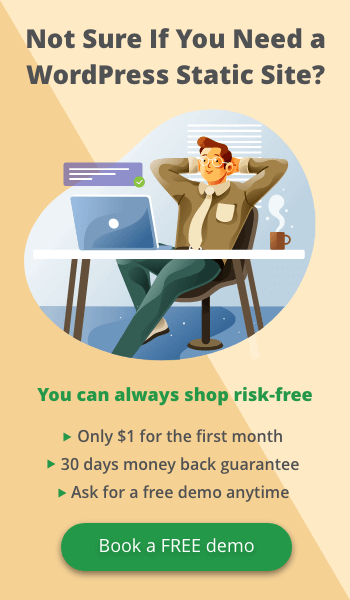How secure are static sites?
Dynamic websites are always exposed on the Internet. They must fetch a database and run applications each time someone makes a request to view a web page. This gives way to malicious attempts like MySQL injections, WordPress botnet attack and other common WordPress attacks. In addition, someone must constantly update WordPress Themes and Plugins to avoid vulnerabilities.
Static sites significantly reduce and, in most cases, eliminate website security risks. Here’s are the main reasons why static sites are more secured:
Eliminate malicious requests: Static sites are more secure because they don’t use a database to store the site files. Plus, there’s no way to make a malicious entry to your backend. Users can only access Html, CSS, images, video, audio, and JavaScript. They cannot override privileges or request unauthorized data.
Highly secure web servers: Security for static sites is handled on the server side. You won’t need to install security plugins and software ever again. FLATsite runs highly secured servers with IP whitelist limitation access and a mix of Iptables and fail2ban firewall. Plus, the static site is hosted on a separate hosting server providing a double layer of security.
Static sites are harder to corrupt: Static site’s files are stored remotely, not on the physical web server hosting the website. So, in case there’s a successful attack the original site can be uploaded to the hosting provider’s server – with zero errors. Plus, backing up static sites is fast and easy.
Eliminates WordPress Update Issues: Never forget a WordPress theme or plugin update again. Static sites remain the same even if you forget to implement WordPress updates. Plugins will work, the site will not break and most importantly, it will not be vulnerable to attacks. Plus, updates are automated in the FLATsite backend. So, all that’s left to do is to push updates online.
FAQ
- Headless WordPress Technology
- FLATsite Platform
- Compatibility
- Getting Started
- Is there a login portal? If yes, what can I expect?
- Where do I edit my website?
- Where are my files stored?
- Who can access my FLATsite account?
- Is there a staging environment on FLATsite?
- Can I test and develop in FLATsite?
- Do I need to manually deploy services? If Yes, how?
- Can I Generate a Static Site from a WordPress Site with just one-click?
- Can I render all blog posts in my WordPress site to static HTML site automatically?
- How do I migrate my site to FLATsite?
- Security


